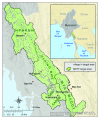Scale up of a Plasmodium falciparum elimination program and surveillance system in Kayin State, Myanmar
- PMID: 29384151
- PMCID: PMC5701446
- DOI: 10.12688/wellcomeopenres.12741.2
Scale up of a Plasmodium falciparum elimination program and surveillance system in Kayin State, Myanmar
Abstract
Background: Myanmar has one of the largest malaria burdens in the Greater Mekong Subregion (GMS). Throughout the GMS, Plasmodium falciparum parasites are increasingly resistant to artemisinin combination therapies. Given that there are no current alternative treatment therapies, one proposed solution to the threat of untreatable P. falciparum malaria is to eliminate the parasite from the region. Several small-scale elimination projects have been piloted in the GMS, including along the Myanmar-Thailand border. Following the success of the pilot elimination project along the Myanmar-Thailand border, there was a scale up to a broad area of Eastern Kayin State, Myanmar. Here we describe the establishment of the scale up elimination project in Easter Kayin State. Methods: The scale up relied on geographic reconnaissance and a geographic information system, community engagement, generalized access to community-based early diagnosis and treatment, near real-time epidemiological surveillance, cross sectional malaria prevalence surveys and targeted mass drug administration in villages with high prevalence of P. falciparum malaria. Molecular markers of drug resistance were also monitored in individuals with symptomatic and asymptomatic infections. Discussion: This protocol illustrates the establishment of an elimination project and operational research in a remote, rural area encompassing several armed groups, multiple political organizations and a near-absent health care infrastructure. The establishment of the project relied on a strong rapport with the target community, on-the-ground knowledge (through geographic surveys and community engagement), rapid decision making and an approach that was flexible enough to quickly adapt to a complex landscape. The elimination project is ongoing, now over three years in operation, and assessment of the impact of this operational research will follow. This project has relevance not only for other malaria elimination projects but also for operational research aimed at eliminating other diseases.
Keywords: Burma; Karen; Kayin; Myanmar; Plasmodium falciparum; early diagnosis and treatment; elimination; mass drug administration; operational research.
Conflict of interest statement
Competing interests: The authors report no competing interests.
Figures



References
-
- Oo TT: Biology and vector competence of the anopheline mosquitoes of myanmar with special consideration of anopheles dirus . Ruperto-Carola University of Heidelberg, Germany;2003. 10.11588/heidok.00003305 - DOI
Grants and funding
LinkOut - more resources
Full Text Sources
Other Literature Sources

